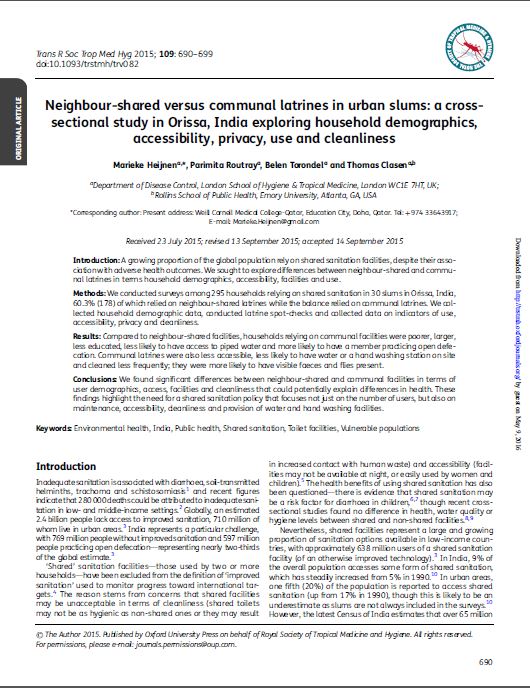Neighbour-shared versus communal latrines in urban slums: a cross-sectional study in Orissa, India exploring household demographics, accessibility, privacy, use and cleanliness
 |
Latrines partagées à l'échelle du voisinage versus latrines communales: une étude transversale en Orissa, Inde, explorant la démographie des ménages, l'accès, l'usage et la propreté
article Sep 2015 ; 10 pages
Aut. Thomas F. Clasen & Marieke Heijnen & Parimita Routray & Belen Torondel
Ed. Oxford Journals - Oxford
Téléchargeable sous format: PdF
Téléchargeable chez l'éditeur
Page de présentation d'un éditeur
Abstract:
Introduction:
A growing proportion of the global population rely on shared sanitation facilities, despite their association with adverse health outcomes. We sought to explore differences between neighbour-shared and communal latrines in terms of household demographics, accessibility, facilities and use.
Methods:
We conducted surveys among 295 households relying on shared sanitation in 30 slums in Orissa, India, 60.3% (178) of which relied on neighbour-shared latrines while the balance relied on communal latrines. We collected household demographic data, conducted latrine spot-checks and collected data on indicators of use,
accessibility, privacy and cleanliness.
Results:
Compared to neighbour-shared facilities, households relying on communal facilities were poorer, larger,
less educated, less likely to have access to piped water and more likely to have a member practicing open defecation. Communal latrines were also less accessible, less likely to have water or a hand washing station on site and cleaned less frequently; they were more likely to have visible faeces and flies present.
Conclusions:
We found significant differences between neighbour-shared and communal facilities in terms of user demographics, access, facilities and cleanliness that could potentially explain differences in health. These
findings highlight the need for a shared sanitation policy that focuses not just on the number of users, but also on
maintenance, accessibility, cleanliness and provision of water and hand washing facilities.
Public-Cible:
Mot clef: |
Pays concerné: |
Editeur/Diffuseur: |
|
Oxford Journals - Oxford - Royaume Uni |
En cas de lien brisé, nous le mentionner à communication@pseau.org